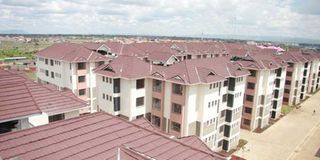Demand keeps buyers flooding in, builders smiling

An estate under construction along Mombasa Road. PHOTO | FILE
What you need to know:
- Kenyan property prices have risen almost threefold in the past decade
- Nairobi is heading for an extreme shortage of middle-class housing if nothing is done to address the current shortfall
The boom in Mombasa’s property sector does not come as a surprise to those who have been watching the industry. As other sectors, including agriculture and tourism, report subdued performance, investors in real estate are brimming with confidence after reporting significant growth in the first three months of 2014.
That growth is being driven by, among others, government employees and private sector staff who are now able to obtain flexible loans from institutional saccos, says Daniel Ojijo, the chairman of Mentor Holdings and co-founder of Kenya Homes Expo.
In Nairobi, for instance, Gideon Ngure, the group business development manager at Sigimo Enterprises, says one of the company’s projects, Belcrest Gardens, which comprises 28 three-bedroom apartments in Kileleshwa, sold six units at Sh17.5 million each in the first three months of the year. “Five of the six buyers were Kenyans, including government employees and staff from the private sector,” reveals Ngure.
Now, if you are not a keen observer of the market, that would not mean anything to you. But consider this: Six units sold in three months, each at Sh17 million and within the same development, can only mean one thing: Kenya’s real estate market is defying prevailing market conditions, including high interest rates, delayed issuance of construction permits, the talk about a ballooning wage bill, and the recent cut in economic growth projections from 5.6 per cent in 2013 to 5.1 per cent, according to the National Treasury.
Ojijo adds that the growth in the sector in the first three months of 2014 was vibrant across major towns such as Thika, Machakos, Mombasa, Kisumu, and Nakuru, which are seen as high-potential zones by developers, hence the eagerness to shift focus from Nairobi. However, Nairobi has better infrastructure and, because it plays host to various multinationals and the diplomatic corps, developers still find it the most attractive prospect.
Kenyan property prices have risen almost threefold in the past decade. The market is underleveraged, with a near-insignificant proportion of mortgage-financed purchasing and ongoing demand growth amid rising shortages, making for a flexible price trend through all shocks, analysts say.
Though the growth in the past three months is across all the income groups, there has been more buying activity in the middle- and low-income segments than in the high-end segment, Ojijo says.
In the last three months of 2013, the HassConsult Property Index reported stalling house prices, especially in the high-end and middle-income housing segments as high mortgage rates locked out first-time home buyers. The index also reported that the average sale price for housing units in Nairobi’s main suburbs had stagnated in 2013 and in some cases dipped due to low demand.
However, according to Ojijo, the festive season had a lot to do with the stagnation as market dynamics shifted growth to other sectors such as tourism and hospitality, which recorded growth in the last quarter of 2013. “This shift can be explained by the fact that there has been high growth in the sector in the first three months of 2014 as investors come back to business from the festive season and start making investment choices,” argues Ojijo.
“Real estate still remains the best choice of investment for most people. Also, the sustained high performance of the sector can be related to the fact that demand for housing is not seasonal but constant, and in Kenya most housing needs are yet to be met.”
The Kenya Property Developers Association and HassConsult have warned that Nairobi is heading for an extreme shortage of middle-class housing if nothing is done to address the current shortfall. And, with the city’s population expected to reach five million people by 2020, from the current 3.5 million, things can only get dimmer — or rosier, depending on which side of the divide you stand. The country’s aim was to build 200,000 housing units a year in Nairobi to create a world class middle-income city by 2030, but in 2013, only 15,000 units were constructed, 90 per cent of them apartments.
Still, there is hope for the city, both from the private sector and the government. Plans are underway, for instance, to facilitate the development of 300,000 housing units all over the country within the next three years. The government is fast-tracking this programme by evaluating bidders to develop 6,200 housing units in Starehe, Shauri Moyo, and Parkroad in Nairobi County. Charity Ngilu, the Cabinet secretary for Land, Housing and Urban Development, speaking during the official opening of the 19th Kenya Homes Expo last week, said the development of 68,000 housing for the National Police Service would be done through Public Private Partnerships (PPP) and would be rolled out soon.




